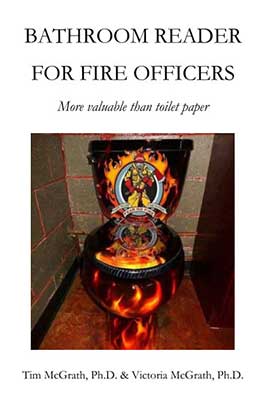Influence of the Shift Officer
by Dr. Tim McGrath, Dr. Victoria McGrath, and Chief A. Lewis Landry, Ret.

How problematic is a weak officer? How important is officer training? Is the transition from blue shirt to white shirt in your fire department a formal process or just evolution in the form of seniority or favoritism? We would suggest the blue to white shirt transition is not only important - it is critical to the culture of your organization. It is not uncommon to find fire departments with three shifts functioning as three different fire departments. And in cases of multiple stations, sometimes even more. Sub-cultures can develop very strongly when the chief allows a high degree of autonomy to flourish and divide the department from a common mission.
For the past several years we have interviewed shift officers individually, not only recording their comments, but also their non-verbal communication, attitudes, management philosophies and behavior. What we have found is the shift personnel under these officers respond and behave very similarly; in fact "group think" and "group act" would be appropriate description. This could be a very good or bad thing depending on that officer's dedication, allegiances, work ethics, etc. In other words, the shift personnel can and do become a clone of the leader in a given environment
All employees are individuals, but the continuing influence that their immediate supervisor affects subordinate employees' behaviors, attitudes, and more importantly performance. At the shift level, the shift commander is that influence, and depending on the amount of autonomy that has developed at the shift level, the work group (shift) can develop an identity of it's own, the strength of which depends on the latitudes offered by the management.
Many times a fire chief feels that upon retirement or dismissal of a group leader (such as a poorly performing captain or lieutenant) that his/her troubles with this particular group or shift are over. Unfortunately, in most cases this is not the case; the shift has likely taken on its associated identity from the departed leader, and will continue its traits until they are identified, isolated and remediated
The shift commander is your "linking pin" to the rank and file. No matter how good of a fire chief and leader you believe you are; the message - as well as how that message is delivered to the personnel by the officer - will dictate the performance level of your department as well as your reputation and perhaps even your future employment.
Shift officers' autonomy is important but shift officers' total independence is devastating to a high performance department. Autonomy, empowerment, and independent thinking are all desirable attributes; however, they must be in balance. Fires get extinguished, people get rescued, and dangerous situations are mitigated successfully through teamwork, consistent training, and strong leadership. Without all of these things working in concert the emergency scene can easily become more dangerous.
Promotional Process
Here are some issues to consider:
- Step 1. Develop job descriptions that include leadership and personnel skills that align with the mission and vision of your department. It is amazing how many job descriptions for officers lack any mention of leadership and management responsibilities.
- Step 2. Assess the leadership skills of the candidate pool objectively. Leadership success is linked closely to interpersonal skills and there is a reason why the troops have empowered the informal leader.
- Step 3. Ensure that your performance evaluations align with the leadership skills that you desire. Begin professional development activities before the appointment of an officer.
- Step 4. In cases where the fire chief has ultimate control as to whom is appointed as the officer; choose wisely - especially in volunteer departments. You want a group that can work together, and with you, not clones of each other. If you work with a Police and Fire or Civil Service Commission spend the time with this group to ensure they are evaluating candidates on the skills needed in your organization.
- Step 5. Some candidate's interview well while others do not; but no candidate can mask his or her leadership/management capabilities when the promotional process includes assessment center testing.
- Step 6. Have regularly scheduled officer meetings - ones that include your shift officers. This should be an opportunity for two-way communication. The fire chief elaborating on the vision and goals of the organization; and the officers communicating the goals and environments of the shifts they supervise. Develop concrete action plans to resolve issues.
- Step 7. Include in your management tool bag "management by bumping into things". In other words get out of the office and onto the floor of the fire station(s). Understand your officers working environment; and by going out into the stations you can praise when appropriate and coach when necessary.
Leading a progressive fire department is difficult and lack of a unified leadership team creates sub-culture environments that can be detrimental to the success of the organization. Being chief of three separate fire departments, depending on which shift is working, should be the first clue that officer training is essential and there are serious problems in the officers' appointment process.





